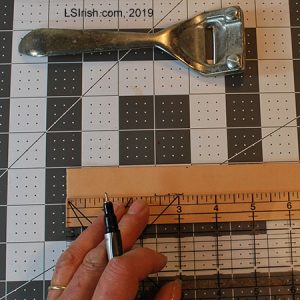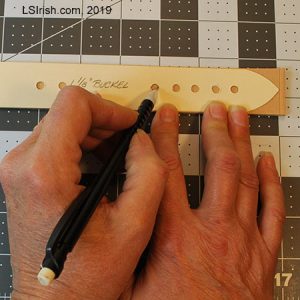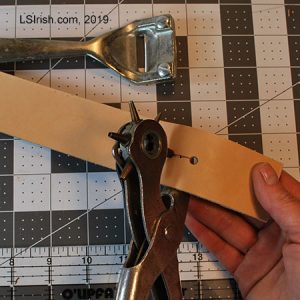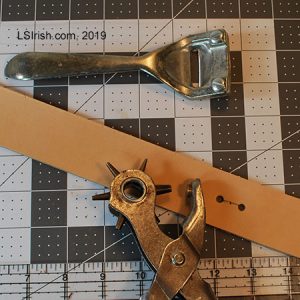 Step 5: Measuring the Buckle Hole
Step 5: Measuring the Buckle Hole
The center point of the buckle hole is marked 2 3/4” (70mm) from the belt blank edge. To create a long slot in the leather through which you will thread the buckle latch, make a mark 3/8” (10mm) on each side of the center buckle mark.
The slot for this belt buckle measures ¾” (19mm) long total. Adjust the size of your slot to fit the buckle you will be using. Wide, thick metal buckles may need a slot as long as 1 1/8” (28.5mm) while small shoe buckles may only need a ½” (13mm) slot. Allow enough length in the slot so that the buckle latch can move freely.
 Step 6: Creating a Card Stock Template
Step 6: Creating a Card Stock Template
Cutting guides can be made out of card stock weight paper and re-used for accurate, easily repeated hole placement.
Often accessory hardware is sold in multiple unit packs. The buckle used in this boot belt came in a package of ten. Since I know that I will be using this style and size buckle in several projects I made a quick cutting and hole placement template out of a card stock file folder. Note on the template that I have labeled it with pencil so that I know which buckle it matches.
 Step 7: Punching the Buckle Hole
Step 7: Punching the Buckle Hole
The two sides of the buckle hole measured line are first cut using a hole punch. The size of the punch is determined by the thickness of your buckle latch.
For this sample the buckle latch measured 1/8” (3mm) wide so I chose a 3/16” (5mm) wide hole punch which gives just a little extra room for the free movement of the latch. One hole is punched at the beginning of your measured line and one at the end.
A rotary hole punch has multiple standard sized hole punches set on a wheel for quick access and hole size changes. The handles are set with an inner spring that helps to drive the punch through the leather surface.
As with many quality tools a rotary hole punch will last for decades, the one shown is from my father’s leathercrafting kit and is about 50 years old.
Both rotary hole punches and drive punches can damage the underside of the leather around the cut hole. You can avoid this problem by placing a piece of scrap leather under your project leather.
There are several methods of cutting or punching holes for the new leather crafter. You can use the rotary hole punch which has multiple sized punches from a small diameter of 1/16” (2mm), up to a large sized ¼” (6mm) punch.
You can also use a round drive punches, which are purchased by the set of four to six standard hole sizes. The drive punch is hand-held in an upright position to the leather, which has been placed on a thick cork board or a thick self-healing poly board, and driven into the leather using a leather or synthetic mallet.
Cork and self-healing poly boards allow the cutting edge of the round drive punch or the hand awl to penetrate their surfaces, therefore protecting the cutting edge of your tools.
